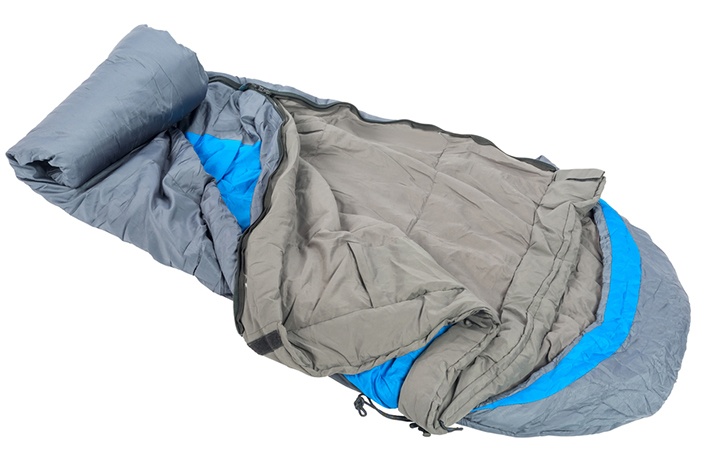Camping outdoors has become a pretty popular recreational activity over the past decade.
Because of so, lots of products like quilts and sleeping bags have been innovated and developed to provide campers with the utmost convenience and comfortability outdoors.
Sleeping bags for one now come in different types including down and synthetic types.
If you are currently looking for a new sleeping bag, but don’t know which one you should get, I highly suggest you take a look at this quick guide about down VS. synthetic sleeping bags before you go out and buy some random sleeping bag for your next camping trip.
More...
Take a quick read of this guide below to see which sleeping bag best fits your preferences and needs.
Down Sleeping Bag Reviews
What Is A Down Sleeping Bag?

Via rei.com
The main difference between a down sleeping bag and a synthetic sleeping bag are their insides.
Down sleeping bags usually contain light plumage that is found under duck or goose feathers.
Advantages
1. This material works as a great insulator because it is made up of fibers that can trap air pockets inside the sleeping bag that help contain heat, thus keeping you warm.
2. What I like about down sleeping bags is that they can be incredibly light.
It’s a great choice for those long treks to the camping grounds or when you’re about to embark on a week-long trip where you’d have to bring lots of food and other gear that will add weight to your baggage.
3. The down sleeping bag compressibility and lightweight build make it a great choice for fully packed camping bags.
Down sleeping bags also tend to be quite durable. You can stuff it in a tight bag and it would still come out all nice and fluffy for you to sleep in.
Unlike low-quality sleeping bags that can lose its shape when packed away improperly, a down sleeping bag can survive being placed in a small compartment in your bag without having its overall structure damaged beyond comfort.
What’s more is that most down sleeping bags can last up to a decade of use. So if you’re looking for something more long-term, you might want to check out down sleeping bags.
Disadvantages
As for its downsides, down sleeping bags do not work well with water.
Get your down sleeping bag wet and you’ll end up with a useless piece of cloth that won’t be able to keep you warm.
Though you may find water repellent down sleeping bags, I still suggest you get a waterproof sleeping bag case to keep your down sleeping bag’s insulation properties in top shape.
Synthetic Sleeping Bag Reviews
What Is A Synthetic Sleeping Bag?

If down sleeping bags are filled with fibers from ducks and geese, what are synthetic sleeping bags filled with?
Unlike the more expensive down sleeping bag, synthetic sleeping bags contain less costly filaments and staple fibers that are able to mimic the down sleeping bag’s light plumage structure that gives the down sleeping bag it’s superb insulation capabilities as well as its compressible structure.
So if you can practically get the same experience from down and synthetic sleeping bags, why should you choose one over the other right?
Well, even though the fibers inside a synthetic sleeping bag perfectly mimic the abilities of a down sleeping bag, the same cannot be said about its overall durability.
Disadvantages
One of the major reasons why synthetic sleeping bags are cheaper than down sleeping bags is because the fibers inside a synthetic sleeping bag cannot retain the sleeping bag’s structure as long as the light plumage inside a down sleeping bag can.
As you compress a synthetic sleeping bag, the fibers inside get damaged over time, which basically means it’s not the best choice for long-term use.
Advantages
But hey, if you’re on a tight budget and are looking for a quick choice, a synthetic sleeping bag may do you just fine.
Though synthetic sleeping bags may not be the best choice for frequent and long-term use, it’s ability to provide insulation in wet situations definitely makes up for it’s lesser quality.
How To Choose The Right Sleeping Bag
Now that you know about the differences between down and synthetic sleeping bags, you may already have an idea as to which kind you should get.
However, knowing the difference between down and synthetic sleeping bags is only one part of the equation.
If you want to get the perfect sleeping bag that best fits your wants and needs, I suggest you take a quick scan at these factors that you should consider before you spend your hard earned cash on some sleeping bag.
1. Price
The first thing you should determine before buying any kind of outdoor gear is your budget.
With all the different kinds of brands, markets, and products available today, you can easily find outdoor gear that fits your budget.
You can try looking for sleeping bags at online stores, malls, even garage sales.
I, however, do not really recommend that you get a second-hand sleeping bag to avoid durability and hygiene issues.
If you are seeking a down sleeping bag, be prepared to shell out approximately $200 up to $300 for a new one and about $80 to $150 for a brand new synthetic sleeping bag.
2. Weight, Insulation, and Compressibility
Weight, insulation, and compressibility are three factors that can highly affect one another when it comes to sleeping bags.
Down sleeping bags for one are made with lightweight plumage that maintains the sleeping bag’s insulation properties and makes it highly compressible at the same time.
Since synthetic sleeping bags are made with polyester fibers, the filling inside the sleeping bag makes it heavier and less compressible despite having the capability to provide adequate insulation.
Simply put, if you are a light backpacker, the down bag is your best choice. Otherwise, a synthetic sleeping bag may provide you with sufficient insulation for a much lower price.
3. Water Capabilities
As mentioned above, the main downside of down sleeping bags is their inability to sustain effective insulation once wet.
When it comes to water capabilities, the synthetic sleeping bag reigns supreme because of its ability to maintain sufficient insulation even when wet. Synthetic sleeping bags even dry faster than down sleeping bags.
If you plan to camp during the rainy season or near bodies of water, your best bet at keeping warm at night definitely lies with the synthetic sleeping bag.
A Quick Recap
As I end this article, allow me to give you a quick recap of the differences between a down sleeping bag and a synthetic sleeping bag.
Remember, down sleeping bags are lighter, more durable, and very compressible. They’re also more expensive and aren’t the best choice for wet conditions.
As for synthetic sleeping bags, they can provide you with insulation even when wet, they dry faster, and they’re cheaper.
On the downside, synthetic sleeping bags are heavier and aren’t as compressible as down sleeping bags.
If you ask me which of these two are the best, I wouldn’t be able to give you a straight answer. It really depends on your backpacking style.
Each of these sleeping bags come with their own pros and cons. Just make sure to tick off more pros than cons when you’re deciding which kind you should get.
Well, there you have it! A short guide about down vs. synthetic sleeping bags. I hope you learned a lot from this article and I certainly hope you had a fun time reading it. If you want to find out about more outdoor gear, I highly encourage you to wander around my blog. You’ll find all sorts of useful information that you can read and share with your friends. This is all for now, see you next time and happy camping!
